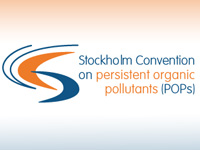UN Expands Dangerous Chemicals Treaty
 Nine persistent organic pollutants (POPs) were listed under the Stockholm Convention. Over 160 Governments concluded a conference with decisions to strengthen the global effort to eradicate some of the most toxic chemicals known to humankind.
Nine persistent organic pollutants (POPs) were listed under the Stockholm Convention. Over 160 Governments concluded a conference with decisions to strengthen the global effort to eradicate some of the most toxic chemicals known to humankind.The Conference of the Parties (COP) Convention was amended for the first time to include nine new chemicals still widely used today as pesticides, flame retardants and in a number of other commercial uses. The new toxic chemicals added expand the original ’’dirty dozen’’ covered by the 2004 Convention. (See the full list here)
“This meeting in Geneva has culminated in a momentous day for the Stockholm Convention. Its significance cannot be under-estimated. We now have a clear signal that Governments around the world take seriously the risks posed by such toxic chemicals”, said UN Under-Secretary General and UNEP Executive, Achim Steiner.
In another move, a groundbreaking decision on synergies was unanimously adopted, marking the collaboration between the Stockholm Convention and its sister treaties on hazardous chemicals and wastes, the Rotterdam and Basel Conventions.
This momentum will gather pace at the UNEP Governing Council Special Session of the Global Ministers Environment Forum slated for February 2010, when an Extraordinary COP will follow immediately afterwards. For the first time, the expanded Working Group will be comprised of the three chemicals and wastes treaties in sequential COPs.
A landmark decision was also reached on the endorsement of the DDT global partnership. While DDT is targeted for eventual elimination by 2020, the Convention recognizes that some countries will continue to use this pesticide to protect their citizens from malaria and other diseases. U.N. environmental and health agencies believe there are good alternatives to combat malaria.
A PCB Elimination Network was strengthened in an effort to phase out harmful polychlorinated biphenyls or PCBs. The Network will establish data needed to track whether the use of PCBs is indeed declining.
The nine new chemicals now listed under the Stockholm Convention are:
- Alpha and Beta hexachlorocyclohexane, used as an insecticide;
- Hexabromodiphenyl and heptabromodiphenyl ethers
- Tetrabromodiphenyl and pentabromodiphenyl ethers used as flame retardants;
- Chlordecone used as an agricultural pesticide
- Hexabromobiphenyl used as a flame retardant
- Lindane used as a broad-spectrum insecticide for seed and soil treatment
- Pentachlorobenzene used in PCB products, dyestuffs, and as a fungicide
- Perfluorooctane sulfonic acid, its salts and perfluorooctane sulfonyl fluoride found in products such as in electric and electronic parts, fire fighting foam, photo imaging.
You can return to the main Market News page, or press the Back button on your browser.

